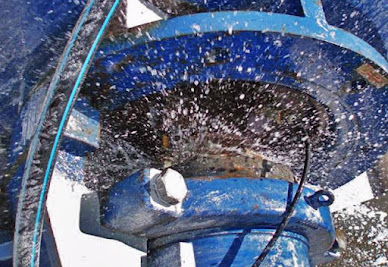Is there a rule of thumb to measure the proper amount of cooling water leakage, when using braided packing on rotary equipment (ex: pumps, agitators, mixers, etc.) ?
Jocelyn Vachon - VP B.Dev / Product Specialist
In order for braided compression packing to seal and work properly on a dynamic equipment, water is injected through a flush line and distributed inside the stuffing box by a lantern ring. A small amount of this water will therefore leak out from the stuffing box.
The objective is twofold :
- A positive pressure of clean water has to be created inside the stuffing box, to prevent process fluid from entering the stuffing box
- To
minimize frictional heat, by creating a hydrodynamic lubricating film
between the stationary packing rings and the rotating shaft. This is a
balancing act between how much compression is exerted on the packing rings
set, to reduce to a minimum process fluid leakage versus limiting
frictional heat.
A mathematical formula does exist to calculate the exact amount of cooling water leakage required on critical equipment. Robco technicians will be happy to produce the calculation for you.
As a rule of thumb, it is suggested to measure about 1 ml / per inch of shaft / minute. No need to bring a measuring cup from your home kitchen... because 1 ml = 8 to 10 drops of water. Therefore, a pump operating with a 2-1/2’’ diameter shaft, that is using a good quality packing, should leak 20 to 25 drops / minute.
Existe-t-il
une règle empirique pour mesurer la bonne quantité d’écoulement d’eau de
refroidissement, lorsqu’on utilise de la garniture en tresse sur un équipement
rotatif (ex: pompes, agitateurs, mixeurs, etc.) ?
Pour que la garniture en tresse de compression fonctionne correctement sur un équipement dynamique, de l’eau est injectée par un tube et répartie à l’aide d’un anneau-lanterne à l’intérieur du boîtier de presse-étoupe. Il y aura donc une petite quantité d’eau qui s’échappera du boîtier.
L’objectif est double:
- Une pression positive d’eau propre doit se créer à l’intérieur du boîtier de presse-étoupe, pour empêcher la migration du fluide de procédé à l’intérieur du boîtier
- Pour minimiser la chaleur de
friction, en créant un film de lubrification hydrodynamique entre les
anneaux stationnaires de garniture et l’arbre rotatif. Il s’agit ici
d’équilibrer la force de compression exercée sur l’ensemble d’anneaux de
garniture, pour réduire au maximum les fuites de liquide de procédé versus
limiter la chaleur de friction


Comments
Post a Comment